Photography courtesy of Lowell Washburn, all rights reserved.
I’ve spent a better part of the past eight days sitting on a South Dakota prairie staring at bison. Although viewing opportunities have varied, there have been some real “Dances With Wolves” moments when peering over a ridgetop, I’ve been greeted to the sight of hundreds of bison methodically grazing the valley floor. Most of my viewing has taken place at Custer State Park. Listed as one of the ‘World’s Top Ten Wildlife Viewing Destinations’, around 2 million visitors tour the 71,000 acre park each year. Nearly all come to see the Custer bison herd which celebrates its 100th anniversary this year. But although total visitor numbers seem staggering, getting away from the crowd is never a problem. All that’s needed is to strap on your hiking boots and put a ridge or two between you and the maintained roadways. From there on, you’re on your lonesome. The only other creatures you’re likely to encounter are bison, pronghorns, elk, mule deer, prairie dogs, golden eagles and rattlesnakes. Simply put, Custer State Park is an excursion into paradise.
I first laid eyes on the Custer bison when my parents brought me here in August of 1958. As surly as a magnet attaches to metal, I was immediately and irresistibly drawn to the shaggy beasts; instantly realizing that there was something “very special” about these huge and magnificent animals. Ever since, I’ve been coming back and back and back for more. Regardless of whether the herds are traveling, grazing, loafing, or fighting; I can literally watch bison from sunrise to sunset without ever getting bored. Standing up to six foot at the shoulder and routinely tipping the scales at a ton or more, the iconic American bison is simply one of the most fascinating mammals on earth.
Historically, bison roamed the open prairies by the tens of millions, covering grassland landscapes from horizon to horizon. For Native Americans — especially to those belonging to the mounted horse cultures of the Northern Great Plains — the bison was everything. Food, fuel, clothing, tools, social customs and traditions all stemmed from and relied upon a bison based economy. During late summer, clans would unite for the purpose of staging large scale communal hunts. Since individual bison herds could number into the thousands, summer hunts were both dramatic and dangerous.
Once a suitable congregation of bison was located, the stalk would begin. When hunters were in position, the signal would be given and the grasslands would reverberate with the cry, “Tatanka Hoka Hey” — “Charge the bison”.
The thundering hooves of stampeding bison literally shook the ground — sometimes to the extent that when running across uneven terrain, it became difficult for pursuing Indian ponies to maintain their balance. During the course of organized communal hunts, scores of bison would be killed; the meat and hides providing ‘new capitol’ needed to sustain villages through harsh prairie winters.
Beginning around the turn of the century and continuing through the early 1930s, noted historian John G. Neihardt conducted personal interviews with surviving Native Americans who had previously lived in the ‘Old Way’ and had hunted bison during the tumultuous era of the mid to late 1800s. Although well advanced in years, the aging hunters recalled details of their life on the open plains with amazing clarity. The following paragraphs are condensed excerpts from first person accounts of a large scale bison hunt staged in present day South Dakota, probably during the summer of 1875 :
“. . . There was a great dust and everybody shouted and all the hunters went in to kill. . . With their quivers full of arrows hanging on their sides, they would ride right up to a bison and shoot him behind the shoulder. Some of the arrows would go in up to the feathers and sometimes those that struck no bones went right straight through. . . . On the way back to the village all the hunting horses were loaded [with meat] . . . we boys who could not wait for the feast helped ourselves to all the raw liver we wanted. . . Everybody was very happy.” Black Elk — Oglala Sioux.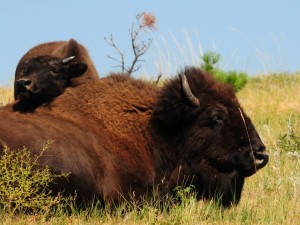
Another account from the same hunt: “I remember that hunt, for before that time I had only killed a calf. I was 13 years old and supposed to be a man, so I made up my mind I’d get a yearling. One went down a draw and I raced after him on my pony. My first shot did not seem to hurt him at all; but my pony kept right after him and the second arrow went in half way. When he went down, I got off my horse and began butchering. All over the plain — as far as I could see — there were men butchering bison now, and the women and the old men who could not hunt were coming up to help. .” Standing Bear — Oglala Sioux
But not all bison hunts occurred in summer. One small party — two older men and two boys — hunted in the midst of a raging prairie blizzard. This hunt probably occurred during the winter of 1877.
“. . . Suddenly the haze opened a little and we saw a shaggy bull’s head coming out of the blowing snow in the draw that led past us. Seven more appeared, and the snow haze came back and shut us in there. We got our horses from the other side of the ridge and came around to the mouth of the draw. The two old men would shoot first and then we two boys would follow the others on horseback. . . . . The old people shot, but they only got one bison. They cried “Hoka!” and we boys charged. The snow was blowing hard and when we came near the bison they were so excited that they turned and backtracked right past us, bellowing. This broke the snow for our horses and made them easier to catch. Suddenly I saw the bison I was chasing go out in a big flurry of snow, and I knew they had plunged into a snow-filled gulch, but it was too late to stop, and my horse plunged right in after them. There we were all together — four bison, my horse, and I all floundering and kicking, but I managed to crawl out a little way. I killed the four bison right there. . . When I went back, I found out the other boy had killed three, so we had eight bison scattered around there in the snow. It was still morning, but it took till nearly dark to do the butchering. We had a big feast; we sang and were very happy. . . About sundown the second day we reached camp. . . some men went back to bring in the meat we had cached.” Black Elk — Oglala, Sioux
But the Old Ways didn’t last. Within a few short years, the federally subsidized extermination of the great herds was nearly complete. By turn of the century, it was estimated that less than one thousand bison remained on the entire continent.
Fortunately, there were a handful of visionaries, who rose to the challenge of preserving this Signature Species of the American Plains. In 1914, conservationist Peter Norbeck arranged to have 36 bison released onto what is now Custer State Park. Currently numbering in excess of 1400 animals, the Custer herd continues to thrive. For those who will actually take the time to really stop, look, and listen; the roaming bison provide a realistic snapshot of America’s past – or at least as good as we‘re going to get in the 21st Century. Sometimes, if a person watches long enough, they may even gain a more unique perspective.
A few years back, I was photographing a herd of about 300 bison in a remote section of the park when a car suddenly appeared in the distance. It turned out to be a group of five Lakota teen-aged boys driving an old Buick gas guzzler down a dirt road for all it was worth. Coming around a nearby curve, the boys spotted the bison, hit the brakes, and slid to a stop amid a swirling cloud of red dust. The windows were down and the driver, along with the guy seated immediately behind him, smiled and waved. Returning their gaze to the bison, the Lakotas stared in riveting silence. No one moved for what had to be the span of three or four minutes of intense viewing. Suddenly, and in unison, all five of the Buick’s occupants burst forth with a series of high pitched, high volume cries. Rocking in their seats, the boys were giving it their all; even the Buick swayed with enthusiasm. Meanwhile, the bison continued grazing with disinterested apathy.
Firing up the cruiser’s engine, the driver threw the machine into gear and the boys disappeared over the horizon. The only reminder of their visit was a lingering trail of dust.
Although the encounter had been brief, the message was clear. The stately Monarch of the Plains will never lose its historic mystic. For a lot of Americans, the bison is, and will always remain, something very special.

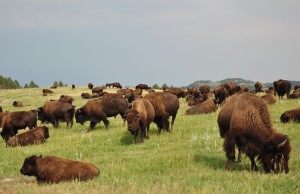
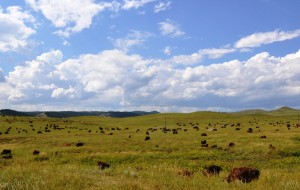
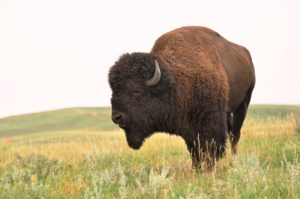
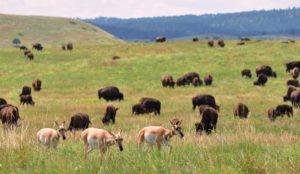
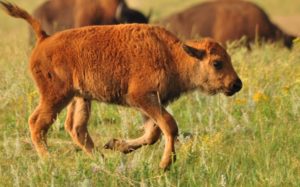
 Tom Cope
Tom Cope Sue Wilkinson
Sue Wilkinson Susan Judkins Josten
Susan Judkins Josten Rudi Roeslein
Rudi Roeslein Elyssa McFarland
Elyssa McFarland Mark Langgin
Mark Langgin Adam Janke
Adam Janke Joe Henry
Joe Henry Kristin Ashenbrenner
Kristin Ashenbrenner Joe Wilkinson
Joe Wilkinson Dr. Tammy Mildenstein
Dr. Tammy Mildenstein Sean McMahon
Sean McMahon